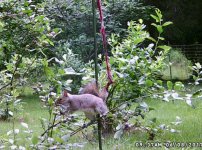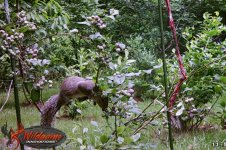We have a row that's maybe 50', and after years of attempts using netting, we almost perfected it last year. I'll skip all of our 'failures' and get to what we'll do this year that I think will be our best and final solution. First, we now have 8' T-posts, driven approximately 1 1/2' in the ground, spaced 10' apart down each side of the row. The rows of posts are at least a couple feet wider than the widest berry plants so nothing interferes with the bushes and we can walk around them all. We leave these posts in permanently, but take down the netting at the end of the berry season.
We add 2' of chicken wire along the bottom of the T-posts, keeping the bottom couple of inches of it flat on the ground to guard against rabbits. Around the top of the T-posts, we wrap a single strand of 3/8" poly rope. That's tied at one corner post, then pulled tight to the next post, wrapped once around the top edge maybe 1" down, and then to the next post and so on until it's a complete loop around the top.
Then comes the light weight bird netting. First around the sides and one end, with the other end able to flap open for a door. We clip the netting with a few clothes pins on the top rope, overlapping the top rope, and along the bottom wire fence. Then we flop a top layer on it, letting it overlap the sides by 1 - 4' depending on the mesh we have. We remove those first few pins on the top rope and then put them back on over both layers of mesh (side and top layer).
The overlapping top seems to keep a better enclosure without worrying about a perfect fit. The chicken wire eliminates the rabbit damage to the lower netting.
I got carried away with the describing the details, and this whole process of adding the mesh takes us minutes to install once a year just before the berries ripen. It's so much better now, being able to walk through and around the bushes without bending and stooping, or pulling the mesh free from the branches.




